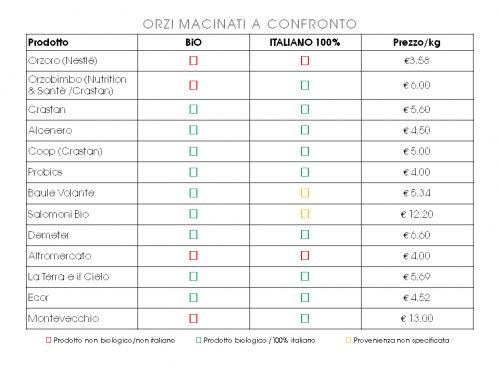
In recent years, the consumption of coffee substitutes has grown greatly, from the classic barley to the mixtures of cereals, legumes and roots of herbs. In the face of an increasingly diverse and not always safe offer, we learn to understand what products steer our choices.
Silvia Wagons
Accomplices are the side effects related to excessive consumption of caffeine, which puts at risk heart disease sufferers, high-blood pressure sufferers, anxious and nervous subjects, and all those who suffer from gastric disorders, so more and more people decide to eliminate coffee from their diet, for the benefit of drinks alternatives.
Thus, in addition to those who are oriented towards decaffeinated blends, there is a growing number of those who prefer the coffee beans of barley grains, or rediscover the old-style coffee, the so-called surrogates, very common in times of war and famine, when the cost of coffee had become prohibitive and people managed with what they had available in the camps.
Anyway these are mixtures that do not contain exciting substances, for which they can be consumed by anyone, at any moment of the day.
Not only barley
The most common alternative to coffee is barley, already mentioned in historical sources from the mid-eighteenth century, the success of which is related to the easy availability, low cost and pleasant taste. This cereal, known for more than 12,000 years old, has a high nutritional value: it is rich in calcium, magnesium, phosphorus, potassium, B vitamins, soluble fiber, and can also count on a low fat content. Hippocrates recommended it as nutritious useful for stimulating digestion, and the ancient Roman gladiators consumed it before the fighting, as to be nicknamed hordeari (from hordeum, barley).
In many mixtures it is possible to find barley associated with barley malt, obtained from the germination of the same cereal, which is often used in combination with dried figs to make the drink sweeter and tastier. In the mix of barley it is also possible to find rye, oats, lupins, broad beans and acorns, once used for the preparation of coffee, however, present in small quantities because of their taste which is rather bitter.
As an alternative to barley, the market also offers chicory, dandelion coffee, drinks which are closely related to our tradition. These are obtained by roasting and grinding the roots, rich in inulin, a compound that during the roasting of starch turns into sugar.
In the market there are also more specific and refined products, such as yannoh, a coffee substitute invented by George Oshawa, the founder of macrobiotics. This is a special mixture of barley, chicory, rye and roasted acorns, characterized by a stronger taste and which is particularly suitable for those who suffer from chronic headaches.
What is better: soluble or ground?
The coffee substitutes for sale come in various forms. The most common are soluble powders and dehydrated granules to dissolve in water or milk; then, the pods and capsules to be used primarily with espresso machines, ending with the traditional roasted beans, to be ground or already ground and ready for infusion.
In all cases, the product is subjected to the process of roasting, in which the full grain or root are roasted at temperatures ranging between 170 and 200 ° C to allow the caramelization of sugars and the formation of aromatic compounds that give the characteristic flavor to the drink.
Unlike other, barley espresso pods is obtained by rapid extraction of toasted or roasted barley, which is then milled to a specific particle size and packaged in pods. In this case, the extraction takes place only at the time of administration of the drink.
More complex, however, is the production of soluble powders, which runs through three distinct phases of manufacturing. It begins as always with the roasting, which in large production, is obtained by exposing the grains to warm air currents that may reach the temperature of 500 ° C, to follow there is the process of extracting the toasted by hot water at 100 ° C (namely it is like making coffee in a huge coffee maker), finally takes place the solubilization, where the infusion is once again hit by hot air that makes the water evaporate and deposits dust. It is clear that many of the nutritional properties, starting with the antioxidants and B vitamins, are dispersed as early as the roasting, so that when we treat ourselves to a good cup of barley or other grain, all that remains is especially reduced in carbohydrates and fiber.
Given the choice, it is preferable to opt for the roasted beans or ground coffee, that suffered of minor mechanical and heat gears, even if they lost several vitamins and minerals. The mixtures can be used with the traditional moka or barley maker, or by boiling them in a pot of water, waiting for the dust to settle on the bottom.
In order to choose the right product it is essential to buy certified organic products that are not gmo which guarantees the entire production chain quality starting from the seed but also the origin is important, that's why you have to reject all the barley coffee, including the organic one, if it is not "100% Italian".
Danger for acrylamide and furan: pay attention to bioaccumulation
Until specific sampling are not carried out, the European Food Safety Authority (EFSA) warned about the risk associated with frequent and habitual consumption of starchy foods subjected to high temperature treatments that develop acrylamide, a chemical compound with carcinogenic and genotoxic properties. This leads us to consider the opportunity to consume barley and substitutes too easily, daily, even several times a day since childhood.
If you have the habit of consuming coffee, barley and dairy products in capsules, to the risk of acrylamide it can be added the danger given by sulforaphane. This organic toxic and carcinogenic compound, which is the result of the processes of roasting, is itself highly volatile, as it is literally imprisoned in these small airtight containers and released again only at the time of consumption, with possible health risks due to bioaccumulation.
Self-produce a good barley, chicory or dandelion coffee
To realize yourself a good barley, chicory or dandelion coffee takes a little time and efforts, especially with regard to achieving the right level of toasting.
The ideal would be to procure an old coffee roaster, a special frying pan with handle on the top or side, that can be found among the ornaments of civilization. Alternatively, we can arrange the grains in a normal pan to be placed on the flame that mustn’t be too high, shaking it often. Once you hear the classic aroma of toasted (not burnt!), you remove it from the flame, you proceed with the coffee grinder and store it in a glass jar.
Slightly different is the preparation of chicory or dandelion coffee. Unlike barley, which, thanks to the presence of silicon has a mild sedative action, chicory stimulates the nervous system, fights sleep and fatigue, and has a mild laxative effect; dandelion, however, stimulates digestion and the pancreas, regulating cholesterol levels. The root of the chicory in particular is rich in inulin, cicorina, choline, tannin, acid cichoric, proteins, minerals and vitamins B, C, K, P.
To make chicory coffee at home we proceed in this way: you have to collect the roots of the plant in a non-polluted places, away from roads and landfills, wash them immersing them in a basin of water and rubbing them well, then cut them into slices and wash them again, you let them dry and reduced them into small pieces, arrange them in the oven for about 2 hours on waxed paper to 220 ° C, leaving the oven door open to let out the moisture. Finally, after the roasting, you have to grind them like coffee beans and you can use wheter the moka (filling the filter in half) or you can also prepare them in the Turkish way.





